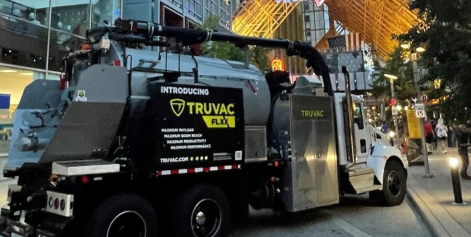Excavation methods play a crucial role in construction, infrastructure repair, and utility locating. With the increasing use of hydro excavation, it’s essential to compare this modern technique with traditional digging methods. Hydro excavation is gaining prominence due to its safety, efficiency, and reduced environmental impact compared to conventional digging. The method involves using pressurized water or air to dig holes and a high-powered vacuum system to remove the spoils, minimizing soil displacement and the risk of damage to underground utilities.
Hydro excavation, spearheaded by TRUVAC, is gaining acclaim due to its safety, efficiency, and reduced environmental impact compared to conventional digging. In order to help our customers make the best equipment decisions for their maintenance, construction, and utility teams, we at Haaker Underground thought it would be important to look into the safety, efficiency, and environmental impact in excavation processes, and provide an in-depth overview of TRUVAC Hydro Excavation trucks and traditional digging methods.
Understanding Hydro Excavation and Traditional Digging
Excavating soil to expose underground utilities is a critical aspect of construction and maintenance projects. Understanding the differences between hydro excavation and traditional digging methods is essential to make informed decisions.
Hydro excavation involves the use of pressurized water to break up the soil, and a powerful vacuum to remove the debris. This non-destructive method is particularly relevant in sensitive or congested areas, as it minimizes the risk of damage to underground utilities. By precisely controlling the water pressure and vacuum strength, operators can expose buried pipelines, cables, and other infrastructure without causing any harm.
Common traditional digging techniques include manual shoveling, trenching machines, and backhoes. While these methods have been used for generations, they come with limitations in terms of safety, precision, and potential damage to underground infrastructure. Manual shoveling is labor-intensive and lacks precision, while mechanical methods such as trenching machines and backhoes pose a higher risk of damaging buried utilities due to their power and scope.
Safety and Risk Factors
Hydro excavation offers inherent safety features that set it apart from traditional digging methods. One of the primary benefits is the reduced risk of utility strikes. By using high-pressure water to excavate, the chances of accidentally damaging underground utilities are minimized. Furthermore, hydro excavation causes minimal soil disturbance, reducing the likelihood of soil collapse during and after the excavation process. Operators are also provided with protective gear and equipment, ensuring their safety during the entire operation. This aligns with industry standards and regulations that promote the use of non-destructive excavation methods, emphasizing the importance of minimizing risks to personnel and underground infrastructure.
Conversely, traditional digging methods present various risk factors, including accidental utility hits, cave-ins, and soil collapse. These dangers not only pose threats to the safety of workers but also have significant economic and legal implications. Accidental utility damages caused by conventional excavation techniques can lead to costly repairs and potential legal ramifications. Additionally, the environmental impact of soil disturbance and potential contamination is a concern with traditional digging practices, highlighting the need for safer and more sustainable excavation alternatives. The distinct advantages of hydro excavation in promoting safety and mitigating risks make it a compelling choice for various digging projects.
Environmental Impact and Sustainability
When it comes to excavation methods, the environmental impact and sustainability play a crucial role in determining the best approach. Hydro excavation is widely recognized for its eco-friendly nature. By using high-pressure water and a powerful vacuum system, this method minimizes soil compaction, ensuring that the soil structure remains intact. This is particularly beneficial as it reduces the risk of soil erosion and preserves the integrity of the surrounding landscape. Additionally, hydro excavation entails minimal disturbance to vegetation, safeguarding the natural habitat and maintaining ecological balance. In terms of water usage, the process involves precise water application, minimizing excess water consumption.
In contrast, traditional digging methods raise significant environmental concerns. Soil erosion is a prevailing issue, as conventional excavation can lead to the destabilization of soil structure, potentially resulting in erosion and sedimentation in nearby water bodies. Furthermore, habitat disruption is a notable consequence of traditional digging, impacting local flora and fauna. Another prominent environmental consideration is the potential contamination of water sources. The use of heavy machinery and the disruption of soil layers during traditional excavation can pose a risk of contaminating groundwater reserves. With the growing emphasis on sustainable construction and infrastructure development, these environmental repercussions have prompted a shift towards more environmentally friendly excavation methods.
By assessing the environmental implications of both hydro excavation and traditional digging, it becomes evident that sustainable practices are integral to minimizing the long-term ecological effects of excavation. As construction and infrastructure development continue to evolve, prioritizing environmentally conscious methods such as hydro excavation becomes increasingly necessary.

In conclusion, our TRUVAC hydro excavation truck offers significant advantages over traditional digging methods, particularly in terms of safety, efficiency, and environmental responsibility. The use of compressed air or pressurized water in vacuum excavation significantly reduces the risk of damage to underground utilities, ensuring a safer work environment for construction and infrastructure projects. Additionally, the non-destructive nature of hydro excavation minimizes environmental impact and promotes long-term sustainability. Embracing advanced excavation technologies such as TRUVAC hydro excavation presents a compelling opportunity for businesses to prioritize safety, streamline operations, and contribute to a more environmentally responsible approach to construction and infrastructure development, which is why we at Haaker Underground are proud to collaborate with them. If you’re ready to dive into safe and efficient excavation for you and your team, contact Haaker Underground at (909) 598-2706 or message us directly today.
